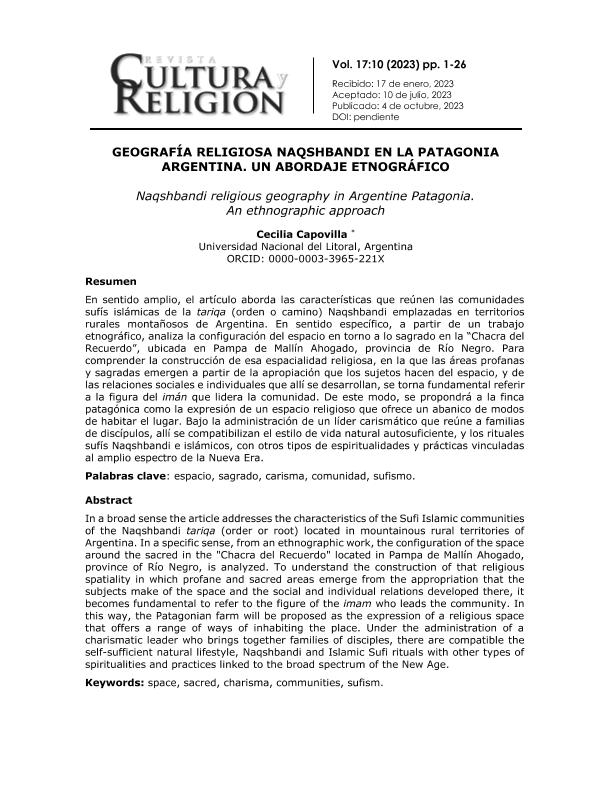Mostrar el registro sencillo del ítem
dc.contributor.author
Capovilla, Cecilia

dc.date.available
2024-02-05T17:35:02Z
dc.date.issued
2023-10
dc.identifier.citation
Capovilla, Cecilia; Geografía religiosa Naqshbandi en la Patagonia Argentina: Un abordaje etnográfico; Universidad Arturo Prat; Revista Cultura & Religión; 17; 10-2023; 1-26
dc.identifier.issn
0718-4727
dc.identifier.uri
http://hdl.handle.net/11336/225856
dc.description.abstract
En sentido amplio, el artículo aborda las características que reúnen las comunidades sufís islámicas de la tariqa (orden o camino) Naqshbandi emplazadas en territorios rurales montañosos de Argentina. En sentido específico, a partir de un trabajo etnográfico, analiza la configuración del espacio en torno a lo sagrado en la “Chacra del Recuerdo”, ubicada en Pampa de Mallín Ahogado, provincia de Río Negro. Para comprender la construcción de esa espacialidad religiosa, en la que las áreas profanas y sagradas emergen a partir de la apropiación que los sujetos hacen del espacio, y de las relaciones sociales e individuales que allí se desarrollan, se torna fundamental referir a la figura del imán que lidera la comunidad. De este modo, se propondrá a la finca patagónica como la expresión de un espacio religioso que ofrece un abanico de modos de habitar el lugar. Bajo la administración de un líder carismático que reúne a familias de discípulos, allí se compatibilizan el estilo de vida natural autosuficiente, y los rituales sufís Naqshbandi e islámicos, con otros tipos de espiritualidades y prácticas vinculadas al amplio espectro de la Nueva Era.
dc.description.abstract
In a broad sense the article addresses the characteristics of the Sufi Islamic communities of the Naqshbandi tariqa (order or root) located in mountainous rural territories of Argentina. In a specific sense, from an ethnographic work, the configuration of the space around the sacred in the "Chacra del Recuerdo" located in Pampa de Mallín Ahogado, province of Río Negro, is analyzed. To understand the construction of that religious spatiality in which profane and sacred areas emerge from the appropriation that the subjects make of the space and the social and individual relations developed there, it becomes fundamental to refer to the figure of the imam who leads the community. In this way, the Patagonian farm will be proposed as the expression of a religious space that offers a range of ways of inhabiting the place. Under the administration of a charismatic leader who brings together families of disciples, there are compatible the self-sufficient natural lifestyle, Naqshbandi and Islamic Sufi rituals with other types of spiritualities and practices linked to the broad spectrum of the New Age.
dc.format
application/pdf
dc.language.iso
spa
dc.publisher
Universidad Arturo Prat
dc.rights
info:eu-repo/semantics/openAccess
dc.rights.uri
https://creativecommons.org/licenses/by-nc-sa/2.5/ar/
dc.subject
Espacio
dc.subject
Sagrado
dc.subject
Carisma
dc.subject
Sufismo
dc.subject.classification
Otras Sociología

dc.subject.classification
Sociología

dc.subject.classification
CIENCIAS SOCIALES

dc.title
Geografía religiosa Naqshbandi en la Patagonia Argentina: Un abordaje etnográfico
dc.title
Naqshbandi religious geography in Argentine Patagonia: An ethnographic approach
dc.type
info:eu-repo/semantics/article
dc.type
info:ar-repo/semantics/artículo
dc.type
info:eu-repo/semantics/publishedVersion
dc.date.updated
2024-02-02T15:50:50Z
dc.identifier.eissn
0718-5472
dc.journal.volume
17
dc.journal.pagination
1-26
dc.journal.pais
Chile

dc.journal.ciudad
Iquique
dc.description.fil
Fil: Capovilla, Cecilia. Universidad Nacional del Litoral. Instituto de Humanidades y Ciencias Sociales del Litoral. Consejo Nacional de Investigaciones Científicas y Técnicas. Centro Científico Tecnológico Conicet - Santa Fe. Instituto de Humanidades y Ciencias Sociales del Litoral; Argentina
dc.journal.title
Revista Cultura & Religión
dc.relation.alternativeid
info:eu-repo/semantics/altIdentifier/url/https://www.revistaculturayreligion.cl/index.php/revistaculturayreligion/article/view/1107
Archivos asociados
